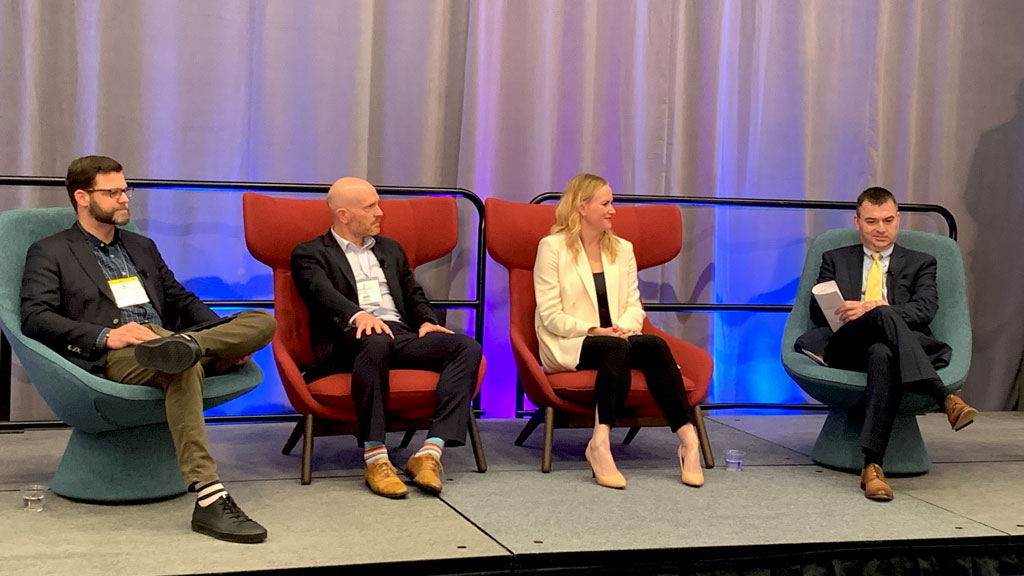B.C.’s construction industry still needs workers, as world events, COVID-19 and demographic shifts increase labour pressures.
A panel of industry experts gave their thoughts on the path British Columbia’s construction industry needs to take to address an ongoing labour shortage in a rapidly changing world at a keynote panel during Buildex Vancouver on March 24.
The panel, titled Solving B.C.’s skilled labour shortage: understanding the construction workforce of 2030 and how we get there was moderated by BuildForce Canada executive director Bill Ferreira and was comprised of BlackBox Offsite Solutions principal Craig Mitchell, Industry Training Authority director of communications Jenny Duncan and Ledcor Construction Vancouver-area regional manager Jonathan Boyce.
Ferreira began by pointing to the pandemic as one factor still impacting B.C. construction industry employment.
“Employment is still 34,800 workers or -14.3 per cent lower than pre-pandemic levels. That’s why you’ve been feeling a bit of a pinch,” he said.
He also pointed out older workers have been slower to return to the workforce and at the same time fewer young people are available to enter the industry.
“Every industry relying on skilled tradespeople, not just construction, will be chasing this shrinking pool,” Ferreira said.
From 2022 to 2027 BuildForce Canada projects 25,000 workers will be retiring from construction and just under 22,000 coming in despite recruitment efforts, he said.
“But we’re only modelling known demands and there are things that will happen that we couldn’t model, like the war between Russia and the Ukraine,” he said.
“Russia exports products we export and the world is not going to forget that. That will, in all likelihood, drive labour demands (in Canada),” Ferreira added.
Mitchell stressed the construction industry needs to expand its recruitment efforts beyond the high school level and change public perception of the sector.
“We have to start at the elementary school level, even high school might be too late. When we ask kids their perception of industry, they think it’s guys on tools or running an excavator but there’s a lot more to it than that,” Mitchell said.
He added the industry’s rapid move to digitization is an opportunity to expand the conversation and spark interest amongst new demographics.
Duncan said attitudes must change across the board for construction to recruit more effectively.
“People in B.C. by and large see the trades as good careers but that flips when you compare it to university degrees. With other peoples’ kids, parents recommend the trades but not your own kid,” she said.
“It’s not just the kids and the teachers but the parents we need to target.”
“To seem relevant compared to the technology industry is a perception and marketing issue,” Boyce said.
“It’s an industry wide, or potentially government wide, initiative we have to show this is a great industry to work in.”
Mitchell said part of the perception problem stems from the view that construction is a “tough” industry “and if you want to attract younger workers, you need to do a better job of becoming more welcoming.”
Duncan pointed to initiatives such as the British Columbia Construction Association’s Builder’s Code as a good start to change worksite conduct that she personally has seen shift attitudes.
“This training has changed the male mindset. After calling out a male colleague about unconscious bias and seeing him change quickly, it was heartening,” she said. “Having this as common practice and training is important to me as a woman.”
Ferreira also pointed to COVID-19 as a catalyst for a huge shift in training practices.
“Is this the new normal and can we expand this because it does bring opportunities to reduce training time going forward?” he asked.
“It was a big switch to virtual out of necessity when covid happened,” Boyce said. “The hybrid model is the way this is going to go.”
“Let’s just face it, hybrid is here to stay,” Mitchell agreed. “Younger groups get all their information virtually. My kids will go ask YouTube or Google when they have a question.”
Mitchell pointed to prefabrication and standardization as ways to reduce the number of workers required for projects.
“BIM and standardization are where we’re going in the next 10 years. Every building being a unique snowflake? We need to get away from that,” he said.
“We also need to focus on how we procure buildings. We need to look at procuring in tens or hundreds of buildings, especially given affordable housing issues.
“That will drive innovation and certainty in the market,” he said.
Follow the author on Twitter @JOCFrey.











Recent Comments
comments for this post are closed